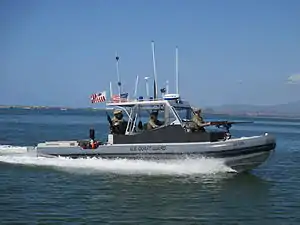32 ft Transportable Port Security Boat (TPSB)
Operated by United States Coast Guard Port Security Units (PSUs), which are composed of Reserve and active-duty personnel, the 32 ft Transportable Port Security Boat (also known as 32' TPSB) provides for defense readiness operations in the United States and when PSUs are deployed overseas. It travels at 43-plus knots, and carries up to two .50 caliber M2 Machine Guns and two 7.62mm M240G Machine Guns. There are 52 in operation.[1]
 A TPSB patrolling Guantanamo Bay | |
| Class overview | |
|---|---|
| Name: | 32 ft Transportable Port Security Boat (TPSB) |
| Builders: | Kvichak Marine Industries |
| Operators: | United States Coast Guard |
| Preceded by: | 25 ft Transportable Port Security Boat |
| General characteristics | |
| Displacement: | 11,306 lbs |
| Length: | 32' |
| Beam: | 8' 6" |
| Draft: | 24" |
| Propulsion: | two(2) 225 hp outboard motors |
| Speed: | 40-45 knots |
| Endurance: | Less than 9 hours |
| Sensors and processing systems: | Radar and communication systems |
| Armament: |
|
| Armour: | Ballistic panels |
The TPSBs perform a variety of missions such has Military Readiness, PWCS (Ports, Waterways, and Coastal Security), Maritime Law Enforcement, Defense Operations, and limited Search and Rescue.
Design
The boats are made of aluminum, designed using Solidworks CAD software in 2010 by Brian M. Shumway, and manufactured in Fairhaven, WA by Aluminum Chambered Boats (ACB) under the supervision of engineer and engineering manager Brady O'hare. The design of the fourth-generation TPSB emphasizes crew protection and comfort over previous TPSBs. To achieve improved comfort and survivability, the TPSBs have greater protection due to the use of ballistic panels. Ballistic protection allows the crew to continue to perform their mission even if fired upon. Comforts improvements come in the use of shock mitigating seats, and better stability. The boats can be transported by plane, or by vehicle with a trailer.[2]
See also
- Defender-class boat
- Equipment of the United States Coast Guard
References
- "Cutters, Boats, and Aircraft, 2015-2016 Edition: Boats" (PDF). USCG.mil. Retrieved 7 August 2018.
- "Enhancing our ability to protect, defend the maritime domain". coastguard.dodlive.mil. Retrieved 28 June 2017.